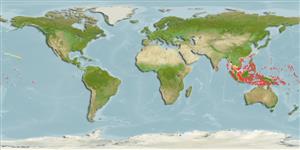Common names from other countries
Environment: milieu / climate zone / depth range / distribution range
Écologie
marin récifal; profondeur 20 - 50 m (Ref. 90102). Tropical; 30°N - 12°S
Western Pacific: southern Honshu, Japan to the Great Barrier Reef and New Caledonia. Reported from the Similan Islands in the Andaman Sea and Guam. Recently recorded from Tonga (Ref. 53797).
Taille / Poids / Âge
Maturity: Lm ? range ? - ? cm
Max length : 60.0 cm SL mâle / non sexé; (Ref. 48637)
Épines dorsales (Total): 5; Rayons mous dorsaux (Total): 27-30; Épines anales 2; Rayons mous anaux: 26 - 30. Lacks a horn, has numerous black close-set spots on the upper half of its body and tail, and is white ventrally. Body elongate, its depth 3.3 to 3.7 times in SL (Ref 9808).
Inhabits coastal to outer reef slopes subject to strong currents. Sometimes in large schools (Ref. 48637). Generally uncommon species found in steep outer reef drop-offs (Ref. 9710). Usually found in waters deeper than 6 m. Feeds on zooplanktons (Ref. 90102). Solitary or in groups (Ref. 37816).
Life cycle and mating behavior
Maturité | Reproduction | Frai | Œufs | Fécondité | Larves
Myers, R.F., 1991. Micronesian reef fishes. Second Ed. Coral Graphics, Barrigada, Guam. 298 p. (Ref. 1602)
Statut dans la liste rouge de l'IUCN (Ref. 130435)
CITES (Ref. 128078)
Not Evaluated
Menace pour l'homme
Harmless
Utilisations par l'homme
Pêcheries: commercial; Aquarium: Commercial
Plus d'informations
Noms communsSynonymesMétabolismePrédateursÉcotoxicologieReproductionMaturitéFraiFéconditéŒufsDéveloppement de l'œuf
RéférencesAquacultureProfil d'aquacultureSouchesGénétiqueElectrophoresesHéritabilitéPathologiesTraitementMass conversion
CollaborateursImagesStamps, Coins Misc.SonsCiguateraVitesseType de nageSurface branchialeOtolithesCerveauxVision
Outils
Articles particuliers
Télécharger en XML
Sources Internet
Estimates based on models
Preferred temperature (Ref.
115969): 24.4 - 28.5, mean 27.6 (based on 73 cells).
Phylogenetic diversity index (Ref.
82804): PD
50 = 0.5000 [Uniqueness, from 0.5 = low to 2.0 = high].
Bayesian length-weight: a=0.01995 (0.00906 - 0.04395), b=3.00 (2.82 - 3.18), in cm Total Length, based on LWR estimates for this Genus-body shape (Ref.
93245).
Niveau trophique (Ref.
69278): 2.9 ±0.33 se; based on food items.
Résilience (Ref.
120179): Milieu, temps minimum de doublement de population : 1,4 à 4,4 années (Preliminary K or Fecundity.).
Fishing Vulnerability (Ref.
59153): Moderate to high vulnerability (49 of 100).
